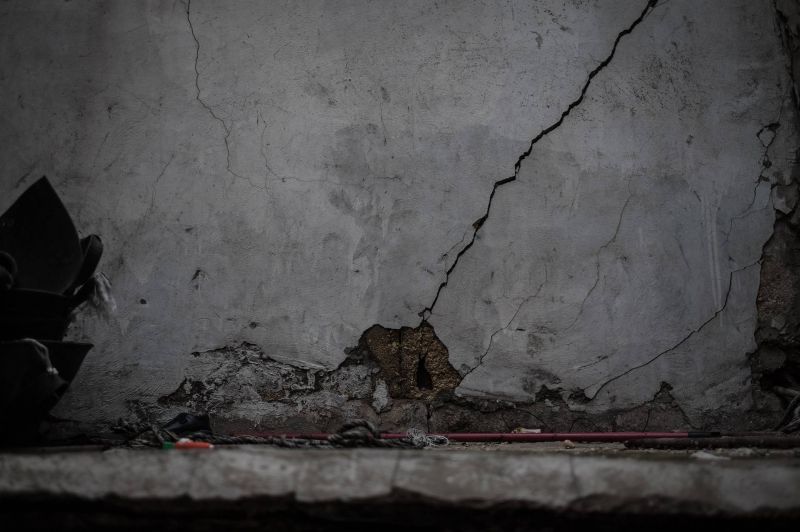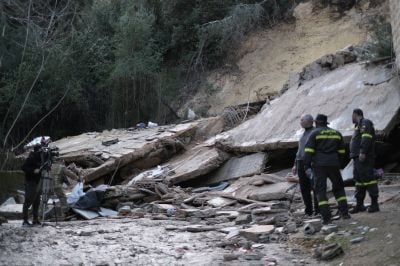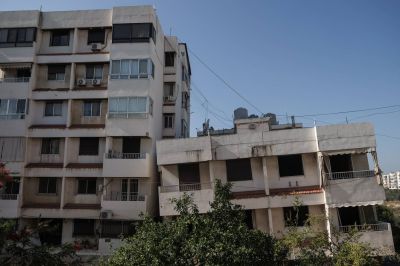
A cracked building in Tripoli's Mina district, Feb. 9, 2023. (Credit: João Sousa/L'Orient Today/File photo)
BEIRUT — At least four people are dead and several others injured Tuesday morning, after their apartment building in the Choueifat area south of Beirut collapsed overnight. It was just the latest in a string of residential building collapses in recent weeks, highlighting poor construction amid increased winter flooding and post-earthquake damage.
Lebanon has been witnessing a disconcerting trend in recent weeks — ticking time bombs disguised as houses and apartment blocks, teetering on the brink.
On Saturday, a two-story building reportedly housing workers in Rihab, Beirut's southern suburbs, collapsed with no casualties reported. The mayor of Ghobeiri, the municipality where the building is located, told local media he was planning to sue the building owners for violating construction laws.
Less than a week before that, the collapse of a five-story building in Choueifat — also with no casualties, as they evacuated just moments before — further emphasized the severity of the situation.
According to the President of the Lebanese Association of Properties, more than 16,260 buildings across the country are at risk of collapse, with significant numbers in Tripoli, North Lebanon and Beirut.
While these figures are approximate and predate the 2020 Beirut port explosion, they underscore the urgent need for addressing structural failures in Lebanon.
Those failures can be deadly. Eight women were killed in the tragic collapse of the Edmond Yazbeck building in Mansourieh in October.
Could better building practices have averted these tragedies and spared more lives?
And can we decipher the warning signs before catastrophe strikes?
What is causing buildings in Lebanon to collapse?
A myriad of man-made factors are contributing to the collapse of buildings in Lebanon, eight of which stand out as primary causes, according to Camille Hashem, a representative from the Order of Engineers and Architects (OEA).
Improper structural conversion: When residential structures are converted to industrial use without adequate reinforcement, the resulting load can exceed the building's capacity, potentially leading to collapse.
Water damage: Repeated exposure to floodwater, especially in areas prone to flooding or near sewage pipes, can seep into and weaken building foundations and columns, particularly if the initial construction was subpar. Water exposure can also exacerbate damage to buildings located in areas prone to soil erosion.
Alteration of building equilibrium: Changes made to the original structure, such as moving columns or knocking down walls, can disrupt the balance of the building and compromise its stability. Even seemingly minor adjustments, like removing sections of walls to expand rooms, pose significant risks.
Overloading rooftops: Placing heavy water tanks or other loads on rooftops without verifying their structural integrity can strain the building beyond its capacity. Architects often fail to consider the additional weight residents might add to rooftops, leading to structural weaknesses and potential collapse.
Inadequate structural assessment: Signs of structural damage, such as water leakage or cracks in walls and support columns, may go unnoticed or unaddressed by residents who lack the expertise to evaluate them properly. Hashem says that residents should consult engineers, specifically construction engineers, for thorough inspections to identify and address potential hazards.
Unregulated building expansion: Adding floors to buildings without consulting engineers can compromise their structural integrity and increase the risk of collapse.
Extended fire damage: Prolonged fires can weaken building materials, particularly load-bearing elements like columns and beams. Failure to rehabilitate structures after significant fire damage leaves buildings vulnerable to collapse.
Aging (or illegal) infrastructure: Buildings older than 50 years need to be inspected and experts should perform rehabilitation works if necessary. Hashem notes that this is the case only if the construction is by the books. Some engineers and architects do not comply with safety regulations when constructing a building or conducting rehabilitation works. In that case, the building needs to be inspected far before the 50-year mark for potential damage.
In Lebanon, the 2005 building law and its 2012 amendments (which passed following the deadly collapse of a residential building in Achrafieh) regulate building safety for all contingencies.
The public safety law enacted in 2005 categorizes all buildings erected before 2005 as “old structures.”

